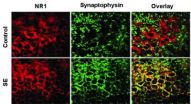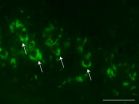(Press-News.org) Fashionable people may turn up their noses at jute — the cheap fiber used to make burlap, gunny sacks, twine and other common products — but new research is enhancing jute's appeal as an inexpensive, sustainable reinforcement for mortar and concrete. The study appears in ACS' journal Industrial & Engineering Chemistry Research.
Subhasish B Majumder and colleagues note that there has been a resurgence of interest in using economical, sustainable natural fibers, rather than steel or synthetic fibers, to reinforce the cement compositions used to make concrete and mortar, the world's most widely used building materials. That reinforcement makes cement compositions stronger and more resistant to cracks. Their previous research showed that jute works as a reinforcement fiber.
The new study discovered another advantage of jute, which is second only to cotton as the most widely used natural fiber. The addition of jute fibers also delays the hardening of concrete and mortar, which must be trucked to construction sites. "The prolonged setting of these fiber-reinforced cement composites would be beneficial for applications where the pre-mixed cement aggregates are required to be transported from a distant place to construction site," the report states.
###The authors acknowledge funding from the National Jute Board of India and CSIR India.
The American Chemical Society is a nonprofit organization chartered by the U.S. Congress. With more than 163,000 members, ACS is the world's largest scientific society and a global leader in providing access to chemistry-related research through its multiple databases, peer-reviewed journals and scientific conferences. Its main offices are in Washington, D.C., and Columbus, Ohio.
To automatically receive news releases from the American Chemical Society, contact newsroom@acs.org.
Follow us: Twitter Facebook
Sustainable reinforcement for concrete has newly discovered benefits
2013-01-16
ELSE PRESS RELEASES FROM THIS DATE:
Development of the first way to make large amounts of promising anti-cancer substance
2013-01-16
Scientists are reporting development of the first practical way to make large amounts of a promising new anti-cancer substance that kills cancer cells differently than existing medicines. Their article on synthesis of the substance, and tests demonstrating its effectiveness in the laboratory, appears in ACS' Journal of Medicinal Chemistry.
Isamu Shiina and colleagues explain that the substance, AMF-26, showed promise against certain forms of cancer in laboratory studies, fostering excitement about its potential for development as a new anti-cancer drug. That excitement ...
Attempts to correct 'death panel' myth may backfire
2013-01-16
Philadelphia, Pa. (January 16, 2012) – Efforts to correct false beliefs about health care reform may backfire, depending on individuals' political views and level of knowledge, suggests a study in the February issue of Medical Care. The journal is published by Lippincott Williams & Wilkins, a part of Wolters Kluwer Health.
In the study, more politically knowledgeable people with positive views of Sarah Palin were likely to harden their opposition to the Affordable Care Act (ACA) when presented with information debunking Palin's "death panel" claim, according to the study ...
New biomarker may help in detecting gliomas, reports Neurosurgery
2013-01-16
Philadelphia, Pa. (January 16, 2013) – Researchers using sophisticated genetic testing techniques have identified a promising new biomarker for diagnosis of glioma—the most common type of malignant brain tumor, reports the January issue of Neurosurgery, official journal of the Congress of Neurological Surgeons. The journal is published by Lippincott Williams & Wilkins, a part of Wolters Kluwer Health.
The biomarker ELTD1 "may serve as an additional biomarker for gliomas in preclinical and clinical diagnosis of gliomas," according to the study by Rheal A. Towner of Oklahoma ...
Promising new finding for therapies to treat persistent seizures in epileptic patients
2013-01-16
LOS ANGELES (Jan. 16, 2013) – In a promising finding for epileptic patients suffering from persistent seizures known as status epilepticus, researchers reported today that new medication could help halt these devastating seizures. To do so, it would have to work directly to antagonize NMDA receptors, the predominant molecular device for controlling synaptic activity and memory function in the brain.
"Despite the development of new medications to prevent seizures, status epilepticus remains a life-threatening condition that can cause extensive brain damage in the patients ...
Using snail teeth to improve solar cells and batteries
2013-01-16
RIVERSIDE, Calif. (www.ucr.edu) — An assistant professor at the University of California, Riverside's Bourns College of Engineering is using the teeth of a marine snail found off the coast of California to create less costly and more efficient nanoscale materials to improve solar cells and lithium-ion batteries.
The most recent findings by David Kisailus, an assistant professor of chemical and environmental engineering, details how the teeth of chiton grow. The paper was published today (Jan. 16) in the journal Advanced Functional Materials. It was co-authored by several ...
Developed new method to diagnose hereditary breast and ovarian cancer
2013-01-16
Researchers of the Catalan Institute of Oncology (ICO) at the Bellvitge Biomedical Research Institute (IDIBELL) have developed and validated a new method to diagnose hereditary breast and ovarian cancer syndrome based on mass sequencing of BRCA1 and BRCA2 genes. The model is based on a genetic and bioinformatic analysis which has been proved very effective. The new protocol has been described in an article published in the European Journal of Human Genetics.
In recent years, new advances in sequencing techniques have involved the development of new platforms for nucleic ...
Dynamic Motivational Author, Speaker & Veteran Deborah L. Parker Keynotes Leesburg Virginia's Martin Luther King March & Program, "Moving the Dream Forward For All of Us" January 21
2013-01-16
Deborah L. Parker remembers the evening of April 4, 1968. In her rural Waverly Virginia home with no indoor plumbing, on the way to the laundromat with her mother, it seemed as if the world stopped. The headline of the evening news: Dr. Martin Luther King Jr. has been assassinated. What happens to the dream? Deborah wondered. She was poor, black, and a good student in a segregated Sussex County. Her mother was a single parent of four and they lived with her maternal grandparents in a shotgun style house on a wooded back road. But her mother was determined and her grandparents ...
Migraine with aura may lead to heart attack, blood clots for women
2013-01-16
SAN DIEGO – Women who have migraines with aura, which are often visual disturbances such as flashing lights, may be more likely to have problems with their heart and blood vessels, and those on newer contraceptives may be at higher risk for blood clots, according to two studies released today that will be presented at the American Academy of Neurology's 65th Annual Meeting in San Diego, March 16 to 23, 2013.
The first study showed that migraine with aura is a strong contributor to the development of major cardiovascular events such as heart attack and stroke. The Women's ...
Higher quality rating for Medicare Advantage plan linked with increased likelihood of enrollment
2013-01-16
CHICAGO – In a study that included nearly 1.3 million Medicare beneficiaries who were either first-time enrollees or enrollees switching plans, researchers found a positive association between enrollment and publicly reported Medicare Advantage star ratings reflecting plan quality, according to a study appearing in the January 16 issue of JAMA.
"To inform enrollment decisions and spur improvement in the Medicare Advantage marketplace, the U.S. Centers for Medicare & Medicaid Services (CMS) provides star ratings reflecting Medicare Advantage plan quality. A combined Part ...
Transmission of tangles in Alzheimer's mice provides more authentic model of tau pathology
2013-01-16
PHILADELPHIA – Brain diseases associated with the misformed protein tau, including Alzheimer's disease and frontotemporal lobar degeneration with tau pathologies, are characterized by neurofibrillary tangles (NFTs) comprised of pathological tau filaments. Tau tangles are also found in progressive supranuclear palsy, cortical basal degeneration and other related tauopathies, including chronic traumatic encephalopathy due to repetitive traumatic brain injuries sustained in sports or on the battle field.
By using synthetic fibrils made from pure recombinant protein, Penn ...

